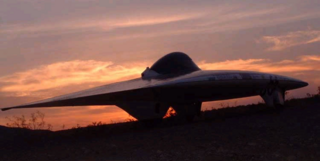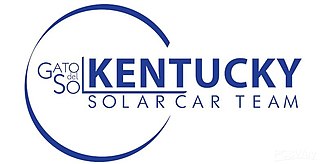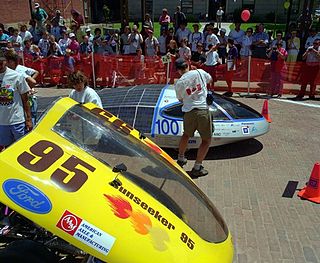Power-to-weight ratio is a calculation commonly applied to engines and mobile power sources to enable the comparison of one unit or design to another. Power-to-weight ratio is a measurement of actual performance of any engine or power source. It is also used as a measurement of performance of a vehicle as a whole, with the engine's power output being divided by the weight of the vehicle, to give a metric that is independent of the vehicle's size. Power-to-weight is often quoted by manufacturers at the peak value, but the actual value may vary in use and variations will affect performance.

Formula SAE is a student design competition organized by SAE International. The competition was started in 1980 by the SAE student branch at the University of Texas at Austin after a prior asphalt racing competition proved to be unsustainable.

The Eliica is a supercar or an battery electric vehicle prototype or concept car first shown in 2004 and designed by a team at Keio University in Tokyo, led by Professor Hiroshi Shimizu. The 5.1 m (17 ft) car runs on a lithium-ion battery and can accelerate from 0–100 km/h (62 mph) in four seconds. In 2004, the Eliica reached a speed of 370 km/h (230 mph) on Italy's Nardò High Speed Track. The team's goal is to exceed 400 km/h (250 mph), breaking the record set by today's street-legal gasoline-powered vehicles.

The American Solar Challenge (ASC), previously known as the North American Solar Challenge and Sunrayce, is a solar car race across the United States. In the race, teams from colleges and universities throughout North America design, build, test, and race solar-powered vehicles in a long distance road rally-style event. ASC is a test of teamwork, engineering skill, and endurance that stretches across thousands of miles of public roads.

The University of Calgary Solar Car Team is a multi-disciplinary student-run solar car racing ("raycing") team at the University of Calgary, based in Calgary, Alberta, Canada. It was established to design and build a solar car to compete internationally in the American Solar Challenge (ASC) and the World Solar Challenge (WSC). The team is primarily composed of undergraduate students studying Engineering, Business, Science, Arts and Kinesiology. The mission of the University of Calgary Solar Car Team is to educate the community about sustainable energy and to serve as an interdisciplinary project through which students and faculty from various departments can collaborate in supporting sustainable energy.
The Cockrell School of Engineering is one of the eighteen colleges within the University of Texas at Austin. It has more than 8,000 students enrolled in eleven undergraduate and thirteen graduate programs. Annual research expenditures are over $267 million and the school has the fourth-largest number of faculty in the National Academy of Engineering.

The University of Minnesota Solar Vehicle Project, or UMNSVP, is a team of undergraduate students from the University of Minnesota that designs and constructs solar-powered cars. In its 31 years, it has established itself as one of the world's top solar racing teams, and the top Cruiser/Multi-Occupant Vehicle team in the Western Hemisphere, with top-two finishes in eighteen of thirty-four events entered.

McGill University's Solar Car Team was composed of students from the faculties of Engineering and Computer Science. From 1990 - 2010, the team designed, built, tested and raced 3 generations of solar vehicles in international competitions. Under the brand Team iSun, the team placed 9th in the 2003 American Solar Challenge from Chicago to Los Angeles, and notably produced the lightest solar vehicle in the competition at 318 lbs. Through the production and racing of solar vehicles, the students on the team learn and exercise teamwork, personal initiative, and responsibility - not only in the engineering disciplines of design and analysis, but also in construction, marketing, project management, and promotion. Team members make an effort to promote engineering and computer science careers in their frequent meetings with elementary school, high school, and CEGEP students.
PrISUm Solar Car is the multidisciplinary student-run solar car racing team from Iowa State University that designs and builds solar powered vehicles to compete in the American Solar Challenge (ASC). The club was founded in 1989 by a group of engineering honor students from Tau Beta Pi and was simply known as the ISU Solar Car Project. In 1990, the team adopted the name of its first car, PrISUm.
Durham University Solar Car, formerly Durham University Electric Motorsport, is a student-run team in the United Kingdom that designs and constructs solar powered cars to compete in international competitions. It is the longest running solar car team in the UK and is financed entirely by third party donations and sponsorship.

A solar car is a solar vehicle for use on public roads or race tracks. Solar vehicles are electric vehicles that use self-contained solar cells to provide full or partial power to the vehicle via sunlight. Solar vehicles typically contain a rechargeable battery to help regulate and store the energy from the solar cells and from regenerative braking. Some solar cars can be plugged into external power sources to supplement the power of sunlight used to charge their battery.
Solar car racing refers to competitive races of electric vehicles which are powered by solar energy obtained from solar panels on the surface of the car. The first solar car race was the Tour de Sol in 1985 which led to several similar races in Europe, US and Australia. Such challenges are often entered by universities to develop their students' engineering and technological skills, but many business corporations have entered competitions in the past. A small number of high school teams participate in solar car races designed exclusively for high school students.

A battery electric vehicle (BEV), pure electric vehicle, only-electric vehicle, fully electric vehicle or all-electric vehicle is a type of electric vehicle (EV) that exclusively uses chemical energy stored in rechargeable battery packs, with no secondary source of propulsion. BEVs use electric motors and motor controllers instead of internal combustion engines (ICEs) for propulsion. They derive all power from battery packs and thus have no internal combustion engine, fuel cell, or fuel tank. BEVs include – but are not limited to – motorcycles, bicycles, scooters, skateboards, railcars, watercraft, forklifts, buses, trucks, and cars.
The Cal State LA Solar Car Team was a group of engineering students at California State University, Los Angeles that developed the Solar Eagle series of solar cars that competed in solar car races in the United States and Australia.

The University of Kentucky Solar Car Team is an independent, student-led project that operates as part of the University of Kentucky College of Engineering. The team's primary goal is to compete in the American Solar Challenge and the Formula Sun Grand Prix over the summer, but they also perform outreach events in which they display and discuss their car with nonmembers.

The Sunseeker Solar Car Project, Sunseeker for short, is Western Michigan University's solar car team. Each vehicle is designed, built, maintained, and raced by students. Sunseeker has competed in all of the American Solar Challenge events, going back to 1990.

Blue Sky Solar Racing is a student-run team at the University of Toronto that designs and constructs solar powered vehicles to race in international competitions.

The Formula Sun Grand Prix (FSGP) is an annual solar-car race that takes place on closed-loop race tracks. In the race, teams from colleges and universities throughout North America design, build, test, and race solar-powered vehicles.

Electric motorsport is a category of motor sport that consists of the racing of electric powered vehicles for competition, either in all-electric series, or in open-series against vehicles with different powertrains. Very early in the history of automobiles, electric cars held several performance records over internal combustion engine cars, such as land speed records, but fell behind in performance during the first decade of the 20th century.

The PowerCore SunCruiser is a solar-powered road vehicle. It was created at the Bochum University of Applied Sciences to compete at the World Solar Challenge in 2013. The PowerCore SunCruiser is the fifth vehicle built by the University of Bochum and categorized as an EC vehicle class L7e, which includes full road approval. The car was presented to the public on 25 July 2013. It offers space for three persons, can reach a top speed of over 100 km/h, and is driven by two wheel-hub motors in the back wheels. Its maximum power is 8.5 kW. The vehicle's empty weight is around 340 kg, of which the batteries take around 63 kg.















